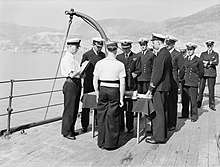Master-at-arms
A Master-at-Arms (US: MA; UK & some Commonwealth: MAA) may be a naval rating, responsible for law enforcement, regulating duties, security, Anti-Terrorism/Force Protection (AT/FP) for/of a country's Navy; an Army officer responsible for physical training; or a member of the crew of a merchant ship (usually a passenger vessel) responsible for security and law enforcement. In some navies, a "ship's corporal" is a position—not the rank—of a petty officer who assists the master-at-arms in his various duties. Historically, a master-at-arms was responsible for the training of soldiers during peace time, or actively involved in leading the defense of a fortification during war time.
In some countries, the term "Navy Police" is used for an institution part of a Navy responsible for law enforcement, such as the Royal Navy Police.
South Africa
United Kingdom

Royal Navy
The master-at-arms (MAA) is a ship's senior rating, normally carrying the rank of chief petty officer or warrant officer. He or she is in charge of discipline aboard ship, assisted by regulators of the Royal Navy Police, of which he is himself a member. The non-substantive (trade) badge of an MAA is a crown within a wreath.
The post of master-at-arms was introduced to the Royal Navy during the reign of King Charles I; their original duties were to be responsible for the ship's small arms and edged weapons, and to drill the ship's company in their use.[1] This was not an onerous task, and masters-at-arms came to be made responsible for "regulating duties"; their role as weapons instructors was eventually taken over by the chief gunner.[2]
The MAA is addressed as "Master" if holding the rank of chief petty officer, regardless of gender, and is often nicknamed the "jaunty", a corruption of the French gendarme, or the "joss/jossman".
As a result of the Armed Forces Act 2006, the term Regulating Branch was changed to Service Police and the branch title changed to the Royal Navy Police and reported to their respective service's Provost Marshal, who was responsible to the First Sea Lord.[3]
British Army
In the British Army, a master-at-arms is a commissioned officer of the Royal Army Physical Training Corps, posted as an SO2 or SO3 at Divisional HQ or higher command, and responsible for overseeing all fitness training in subordinate units. The role is filled by RAPTC WO1s at Brigade HQs, while WO2s or staff sergeant PTIs are embedded at unit level.
United States Navy
In the United States Navy, the Master-at-Arms rating is responsible for law enforcement, Investigations, K-9, expeditionary, and Anti-Terrorism/Force Protection (AT/FP) operations. It is one of the oldest ratings in the United States Navy, having been recognized since the Navy's inception.
References
- Connell, Royal H. and Mack, William P. (2004), Naval Ceremonies, Customs, and Traditions, Naval Institute Press, ISBN 1-55750-330-3 (p. 314)
- ReadyAyeReady.com – Customs of the Navy Chapter 4 – Ranks
- "Regulating Branch and Royal Navy Police Association History". Regulating Branch and Royal Navy Police Association. Retrieved 13 June 2014.